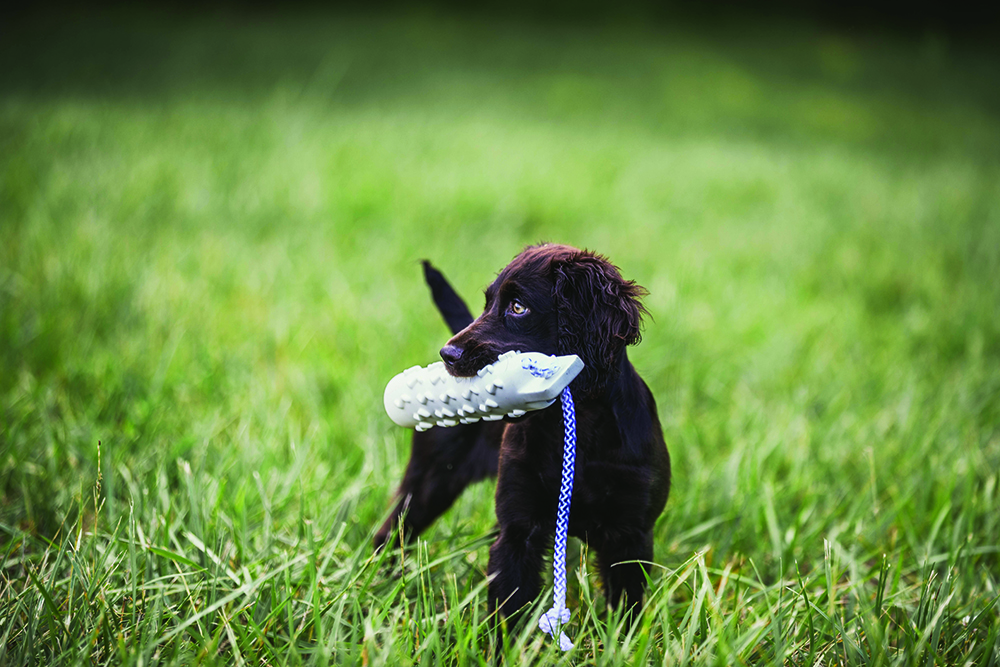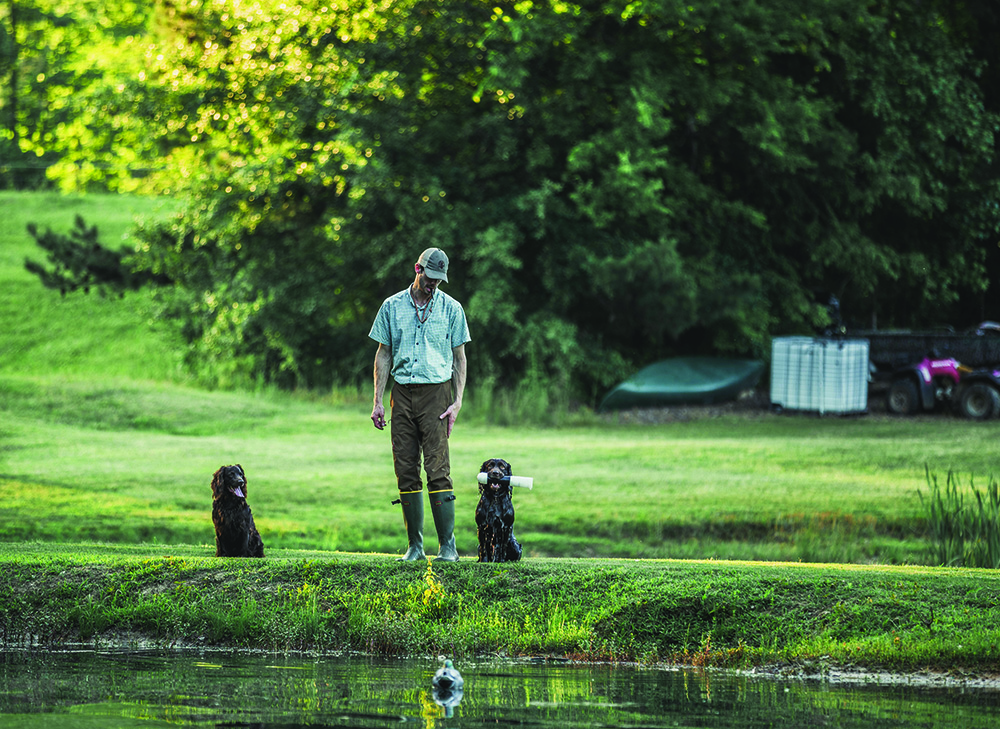Little Brown Dogs

While the lineage of most sporting breeds begins in Europe, the Boykin spaniel started domestically in rural South Carolina as an experiment that valued performance over pedigree. Corroborated oral histories in the book The Boykin Spaniel: South Carolina’s Dog confirm the encounter between Alexander L. White, a banker from Spartanburg, South Carolina, and a reddish-brown stray he named “Dumpy,” as occurring on a summer Sunday between 1905 and 1910. Their chance meeting happened near the First Presbyterian Church of Spartanburg, but apart from these facts, the details of that day vary. Some of the more spurious accounts report Dumpy as having followed White into the sanctuary and that both were ejected after quite a commotion.
White saw some measure of aptitude in Dumpy while working his Chesapeake Bay retrievers. He sent the little stray to his friend and hunting partner Lemuel Whitaker “Whit” Boykin, Sr., who was searching for a compact dog capable of waterfowling from the small boats he used in the Wateree River’s swampy bottoms. Whit also needed a dog that could find wild turkeys and be hidden away in a burlap bag while he called the flock into effective range. Dumpy excelled under Whit’s tutelage, and he sought a suitable female to establish his breed. He found promise in a little brown curly-coated female he named “Singo,”and all Boykin spaniels since and hereafter descend from this pairing.
Whit’s eldest living grandson, Baynard Boykin, believes his grandfather outbred the descendants from his Dumpy x Singo litter to eight different sporting breeds over the next couple decades. He purportedly used springer spaniels, American water spaniels, Brittany spaniels, American cocker spaniels, English field spaniels, English setters, English pointers, and even Chesapeake Bay retrievers. Official records of these litters do not exist, but anecdotal evidence from eyewitnesses and photographs from the 1920s and 1930s account for the development of “Mr. Boykin’s Spaniels” or “those hunting spaniels from Boykin” or “Little Brown Dogs.”

The popularity of these spaniels spread mostly by word of mouth to other parts of the state and region from the 1930s to 1960s. The town of Camden, South Carolina, attracted elite circles of society from across the United States for its charm and reputation for exceptional sporting culture. These influential families wound up with Boykin spaniel pups—and like many other sporting breeds—their handsome features, temperament, and athleticism inspired intrigue. Edmund “Beaver” Hardy, who bears a maternal family connection to Whit Boykin, Sr., whelped his first litter of Boykin spaniels around 1965. Alice Boykin, who was wedded to Whit Boykin II, invited Hardy to a social event where he sold the entire litter of pups for $100 each. Hardy said, “One hundred dollars was good money back then, and Alice called me and said there would be a lot of fancy folks at this party near Camden. I got there quick as I could and didn’t have on cocktail attire, but that didn’t matter since I sold the whole litter!” Hardy said a gentleman from Pennsylvania chose a pup that Alice wanted, so she convinced him the pup was inferior, then whispered to Hardy that she wanted it. “That’s how Alice got pick of the litter.”
Boykin spaniels remained a novelty breed among those in the know until an article by Mike Creel appeared in the September-October 1975 issue of South Carolina Wildlife magazine. His work encouraged a broader interest in the breed, but to meet market demand, irresponsible kennels established themselves apart from the Boykin family. Dr. Peter McKoy, a Camden veterinarian, saw alarming rates of genetic disorders result from these litters, and he approached the descendants of Whit Boykin, Sr., about saving the breed before it was too late. Seven concerned descendants with direct or marital ties to the Boykin family formed a steering committee in 1977. Among them was Baynard Boykin, Henry Beard and his wife Katherine DuVal “Kitty” Beard, and Beaver Hardy. They drafted a letter of appeal to all Boykin spaniel owners with legitimate ties to the breed, encouraging their involvement in the newly formed Boykin Spaniel Society.
“We weren’t sure at first if we would get enough response to establish a registry, but the support was overwhelming, and in the end we wound up with 667 dogs as foundation stock,” Kitty said. Another major undertaking of the steering committee was to establish a breed standard. “Everyone on the committee had their idea about what made the perfect Boykin spaniel, and since everyone on the committee had the “perfect” Boykin spaniel, we had a lot of haggling to do,” Hardy said. They eventually agreed on a breed standard, selected foundation stock, and ensured the breed’s survival for posterity. During his tenure on the board, Hardy lobbied for a piece of legislation to have the Boykin spaniel named South Carolina’s official state dog. Their efforts were successful, and on March 26, 1985, Governor Richard Riley signed this bill into law.

Since 2012, Dawn Crites has served the Boykin Spaniel Society in a full-time role as its sole administrator, and she serves on the board of a subsidiary organization called the Boykin Spaniel Foundation. “The Boykin Spaniel Society focuses on the integrity of the breed while the Boykin Spaniel Foundation maintains and improves the health of the breed,” Crites explained. Health clinics and free screenings for genetic deficiencies are available for registered Boykins so breeders and potential owners can make more informed decisions. Each successive generation of Boykin spaniels and their owners benefit from the dedication of past and present leadership in both these organizations. “It never entered our minds when we started these organizations that they would grow to the extent they have, and I graciously credit Dawn with taking them further,” Kitty said.
True to their original breeding, Boykin spaniels are still multirole sporting dogs that hunt well on both land and water. Though they are not suited for waterfowling in treacherous conditions, a hearty well-trained Boykin will give a Labrador retriever fair competition in shallow sheltered water. In the realm of upland hunting, Boykin spaniels excel in the dove fields due to their heat tolerance, and they fill the roles of flusher and retriever quite well in small pockets of dense cover. They are most at home in Southeastern covers hunting woodcock and bobwhite quail, but often accompany their owners on Midwestern pheasant hunts. Breed-standard Boykin males stand 15 to 18 inches tall and weigh 30 to 40 pounds while females stand 14 to 16 inches tall and weigh 25 to 35 pounds.
Their coats range in texture between curly, wavy, and straight, but eligibility for registration requires they have a solid-colored coat ranging between reddish-brown to dark chocolate, with the only exception being a thin white patch on the chest. Boykin pups are born with blue eyes that change to a golden-brown hue and darken gradually as they mature. Whit Boykin, Sr., docked the tails of his spaniels to prevent them from rustling fallen leaves during autumn turkey hunts, and while a fall season for wild turkeys no longer exists in South Carolina, the docked-tail standard remains in the breed.

Most Boykins bear a companionable and intelligent disposition. They live to please their owners and prefer the company of people to such extent that having them in the home is often recommended. Like other spaniel sporting breeds, their energy levels are high, but with training and regular exercise, most owners find it manageable. A Boykin’s high intellect sometimes creates obstacles during training: They’re often too smart for their own good. Brent Poston of Creekside Kennels in Lexington, South Carolina, said, “A Boykin likes to do calculus to solve a simple problem, whereas other breeds will simply execute.” Brent recommends leaning into their biddability and keeping their training sessions short, light, and positive. “A Boykin wants to learn, so if they’re not working against you, take that into account before applying pressure. Show them what you want out of them first. They prefer you teach them something rather than mandate it, and more often than not, you’ll get a much better outcome from this approach.”
Most people are charmed into Boykin spaniel ownership after meeting one, and once I met my friend Margaret Ellen’s Boykin named “Tackle,” I knew I’d found my next dog. He fathered several litters, and my wife and I wound up with one of his granddaughters. And now my Boykin spaniel—our Boykin spaniel—is laying on the floor of my study, curled into a little brown ball, as I try with words to describe our love for her. She goes by “Fowler” in addition to several aliases: Nutkin, Den Animal, and Proud Prancer (because of a neighbor’s comment about her gait). She knows the sequence of sounds when I open a jar of peanut butter, and regardless of any attempts at stealth and subterfuge, she prances (proudly, of course) into the kitchen and demands her share of its gooey goodness. When I gather my gear from the hunting closet, Fowler sniffs at my game vest and turns dizzying circles toward the front door like the cartooned Tasmanian Devil, her deep-throated barks echoing down the hallway.
Having attempted to train Fowler myself, I accept full culpability for any gaps and deficiencies in her gun-dog education. Every time I shoot at a mourning dove and it doesn’t fall, she barks and whines and paws at the earth until I’m afraid she might reach China if my shooting doesn’t improve. When a brace of pointers slams into a scent cone, she launches into the cover to flush the covey, shrugging off the gnarly briars that cling to her coat and scratch at her skin. But my proudest moment in the four years she’s been ours was when she retrieved a Canada goose. She plunged into the water with as much or more heart than any aquatic athlete and swam a quarter furlong before grabbing its leg and swimming back. She reached the shore and struggled to drag our prize inch-by-inch up the steep bank, and I hobbled down to assist and heap praise upon her. When I tried to send her after a couple more felled geese floating on the water, she flatly refused by explaining to me through high-pitched barks and prancing-in-place that she didn’t have the gas to get another…and I don’t blame her one bit given they weigh half as much as her.
If it’s true that all dogs go to heaven, then this Little Brown Dog surely will. And if I’m fit enough for the kingdom and we meet again, I’ll apologize to her for the inequitable exchange of being able to have offered her only a part of my life—because she will have given me all of hers.
Originally published in Volume 10, Number 2 (Feb-Mar 2022) of Covey Rise.
























